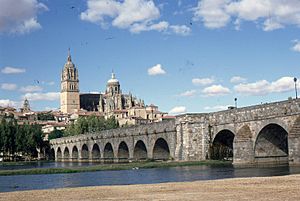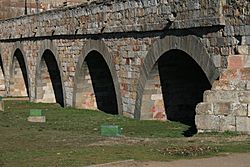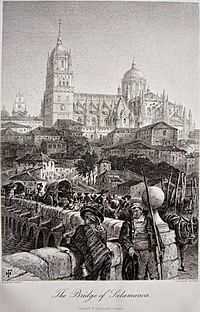Roman bridge of Salamanca facts for kids
Quick facts for kids Roman bridge of Salamanca |
|
|---|---|
 |
|
| Coordinates | 40°57′28″N 5°40′13″W / 40.95777°N 5.67018°W |
| Crosses | River Tormes |
| History | |
| Closed | 1973 |
The Roman bridge of Salamanca (in Spanish: Puente romano de Salamanca) is an ancient Roman bridge. It crosses the Tormes River in the city of Salamanca, Spain. This bridge is very important to Salamanca. You can even see it on the city's coat of arms, along with a stone bull statue called a verraco.
People used to call it the "main bridge" because it was the main way to get into the southern part of the city. The bridge you see today has been fixed up many times over the years. A huge flood in 1626, called the Flood of San Policarpo, caused a lot of damage. The bridge was named an "Artistic Historic Monument" in 1931. Until the early 1900s, it was the main road into Salamanca. It carried heavy traffic until 1973. Now, a newer bridge handles cars, and the Roman bridge is only for people walking.
The bridge is actually made of two parts. They are separated by a central section. The part closer to the city is the "old bridge" and is truly Roman. The other part is the "new bridge." Out of its twenty-six arches, only the first fifteen are from Roman times. The stones used are different too. The Roman part uses granite from Los Santos, while the newer part uses stone from Ledesma. The bridge has been fixed many times and has even survived attempts to tear it down. We don't know the exact date it was built. It was likely built between the time of Emperor Augustus (27 BC - 14 AD) and Emperor Vespasian (69-79 AD). This makes it a monument that is over 2,000 years old!
Contents
History of the Bridge
The history of the Roman bridge is closely linked to Salamanca. It is one of the city's most famous landmarks. Other famous spots include the two cathedrals, La Clerecía, and the Plaza Mayor. Long ago, people believed the hero Heracles first built the bridge. Then, they thought the Roman Emperor Trajan rebuilt it. This idea came from a tombstone found in 1606. However, that stone actually referred to repairs on a Roman road called the Vía de la Plata. In 1767, a medal honoring Heracles was found in one of the bridge's arches. This made the old myth even stronger.
Later research shows the bridge was built in the second half of the 1st century AD. It was needed to help travelers cross the Tormes River. These travelers were using the Vía de la Plata, a major Roman road connecting Mérida and Astorga.
When Was the Bridge Built?
A stone bull statue, called a Verraco, was known to be next to the bridge as early as the 1200s. In 1606, a historian noted that Salamanca's coat of arms showed this stone bull. Even though the verraco is older, the bridge itself was built during Roman rule. The Roman road, the Iter ab Emerita Asturicam, needed a bridge near Salamanca. But we don't have clear records or proof to know the exact date it was built.
Some historians think the bridge was built around the time of Emperor Nero. Others believe it was during the time of Trajan and Hadrian. This is because the bridge looks similar to the Aqueduct of Segovia. These ideas come from studying old milestones along the road, not from the bridge itself.
The Vía de la Plata road was finished in all its parts by 19 BC. Roman writers described how Roman soldiers were spread out across Hispania (ancient Spain). This shows that the road was important for moving troops.
When Emperor Augustus visited Spain between 16 and 13 BC, new towns started to appear along the roads. Many of these towns were involved in mining. This meant that public works, like bridges, were needed to make travel and trade easier. During the time of the Flavian dynasty (69-96 AD), there was a lot of building activity in northern Spain. Gold mines in Las Cavenes started operating in the early 1st century. This suggests the bridge might have been built during Trajan's rule. This was a time when many towns were becoming important centers. It's also possible that the bridge was not all stone at first. It might have been a mix of stone and wood.
After the Roman Empire, we don't have much information about the bridge. We don't know its role during the invasions by groups like the Suebis, Vandals, and Alans. We also know little about it during the long rule of the Visigoths.
From the Middle Ages to the 1700s
The Tormes River often floods. It's possible that the original Roman bridge was longer than it is today. The newer, "Hispanic" part might have been rebuilt after a big flood in the Middle Ages. The bridge was very important for connecting with the Kingdom of León during the Reconquista. However, we only find written records of the bridge starting in the 12th century. People and goods were controlled at the bridge, and a tax was collected there.
One of the first major floods happened in 1256. It was called the Ríada de los Difuntos. This flood damaged the southern part of the bridge. We don't know if the "new" part of the bridge was built after this flood.
By the late 1400s, the bridge was known as the "main bridge of the city of Salamanca." It suffered another big flood in 1498. In the early 1500s, the Tormes River was considered one of the most dangerous rivers in Spain because of its huge floods. In 1570, a painter named Anton van den Wyngaerde drew the bridge and the city.
In 1626, the Flood of San Policarpo caused a lot of damage to the city. Two of the bridge's medieval arches collapsed. Other arches also fell down up to the central tower. But the Roman part of the bridge stayed strong. Major repairs happened in 1627. The central tower and its battlements were removed.
The Bridge After the 1626 Flood
The bridge was repaired again in 1767. It kept its eleven modern arches and fifteen Roman arches.
On July 22, 1812, during the Peninsular War against the French army, a big battle happened south of Salamanca. It was called the Battle of Salamanca. The bridge was a very important target for the armies. The day before the battle, the Duke of Wellington took control of the bridge. From there, he could plan his attack against the French troops.
Famous painters also showed the bridge in their art. David Roberts painted it in 1837, and Gustave Doré painted it in 1862.
See also
 In Spanish: Puente romano de Salamanca para niños
In Spanish: Puente romano de Salamanca para niños





